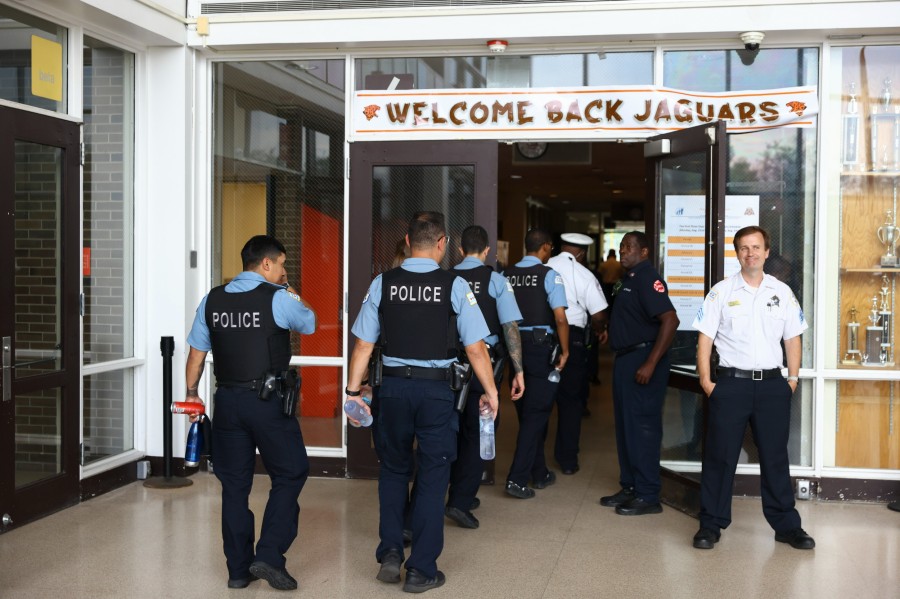After Highland Park and Uvalde, CPS prepares for emergencies — and supporting kids through trauma
CPS says it’s ready for the worst. But the district also wants to take a “holistic” approach to safety that addresses students’ worrisome behavior by seeking the root causes.
By Nader Issa | Chicago Sun-Times

After Highland Park and Uvalde, CPS prepares for emergencies — and supporting kids through trauma
CPS says it’s ready for the worst. But the district also wants to take a “holistic” approach to safety that addresses students’ worrisome behavior by seeking the root causes.
By Nader Issa | Chicago Sun-TimesA couple dozen Chicago police officers, paramedics and other emergency personnel filed into Julian High School on Thursday, with a mobile police command center parked outside and officials donning neon vests visible through the lobby windows.
The team was participating in an active shooter drill, the first at Chicago Public Schools since 2018, in preparation for the new school year and in the wake of mass shootings around the country — particularly the Uvalde, Texas, massacre that left a couple dozen children and educators dead.
CPS officials said the drill would help fine-tune their emergency plans and show families and staff that they’re ready for the worst. They also announced an $8 million investment in security technology — cameras, alarm systems, metal detectors and more — plus an expanded program to monitor and report social media threats of violence.
But district leaders also said the CPS parents they’ve consulted don’t have school shootings as top of mind as much as violence outside of schools.

“Universally, people feel safe in the schools,” said Jadine Chou, the district’s safety and security chief. “People tell us schools still are their sanctuary.
“The challenge we face is how do we make sure they also feel safe out in the community.”
CPS CEO Pedro Martinez this week called on the city to help support students through trauma and community gun violence. He said the district is building its capacity to identify kids who need support, but there’s often nowhere to refer them for that help. And creative ideas are needed between city agencies and community groups to keep kids safe.
Since major protests in the summer of 2020 targeted the disproportionate policing and discipline of Black and Latino students — and the presence of police officers in schools — CPS has shifted to a so-called “holistic” approach to school safety. Students’ mental and emotional safety are as important as physical safety, and addressing problems at their core rather than papering over them is seen as a more caring approach.
That means supporting kids who have experienced trauma, whether from violence, poverty, bullying, family loss or something else. In the case of social media monitoring, Chou said the goal isn’t “Big Brother” surveillance, of which the district has been accused in the past. If a concerning post is made, the idea is to figure out the reason behind that child’s feelings.
“Our approach is, we want to get to the root of why you did that, and in some cases it may be as a result of someone bullying somebody,” Chou said. “So just applying a criminal charge doesn’t get to the root of that.
“This ties together with our approach to discipline. Wouldn’t we rather have our children closer to us when they’re going through something so we can solve that as opposed to saying you need to stay out of the building.”
Stacy Davis Gates, president of the Chicago Teachers Union, said educators have been begging for additional trauma and restorative justice resources for years, but the resources to deal with trauma aren’t fully developed or offered.
“Look what they’re doing in Highland Park, all of the resources the people in those school communities are going to receive because of the tragedy that happened,” she said. “That is exactly what is supposed to happen. That is exactly what they deserve.
“We have to fight to get a fraction of what they’re going to receive because there’s political will, because there’s an acknowledgement of their humanity, because there is a love for those people.”
Davis Gates said a social worker and a nurse in every school — key victories in the CTU’s 2019 contract after an 11-day strike — are “not even the bare minimum.”
“Our violence is sustained. There’s no post-traumatic in Chicago,” Davis Gates said. “Our violence is persistent, which means that you can suffer that type of trauma or tragedy more than once. And people are bringing that trauma into school communities.”
